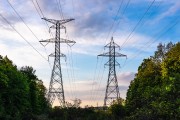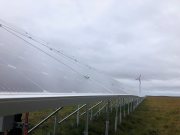The Yukon, Northwest Territories (NWT), and Nunavut face distinct challenges in progressing their clean energy ambitions. All three territories operate independent electricity grids and are disconnected from the rest of North America, making their energy transition unique in its own right. The combination of their isolation, harsh climates, small and widely dispersed populations, and capacity constraints all result in clean energy projects which cost more and take longer to build. These challenges are further deepened for remote communities across each territory, where diesel is the main fuel source used to power communities.
Reducing emissions costs orders of magnitude more in the north than in Canadian provinces. The result of this being that clean energy projects struggle to be economically viable without funding support from both federal and territorial levels of government. As Canada increases ambitions for emissions reductions and clean electricity, with commitments to achieving a net-zero electricity grid by 2035 and net-zero greenhouse gas (GHG) emissions by 2050, the territories must be afforded opportunities to join Canada in moving towards clean, reliable, and affordable energy generation and creating sustainable economic opportunities.
However, Canada’s current strategies and tools for decarbonization frequently do not meet the needs of northern jurisdictions or exclude the territories entirely, for example with exemptions from the Clean Fuel Regulations and Clean Electricity Regulations. These regulatory exemptions are rationalized by concerns for the availability of clean energy solutions and cost of living impacts in the territories. There are also decarbonization funding eligibility exemptions, for example from the Smart Renewables and Electrification Pathways Program (SREP) and Oil to Heat Pump Affordability program.
Inability to access programs, often as a result of regulatory exemptions, mean territories are left behind as Canada and the provinces continue to advance their clean energy efforts. Fit for purpose transition pathways are required for the North to undertake their own clean energy transition, including through inclusive funding models for communities, utilities, and territorial governments.
Enabling Indigenous-owned renewable energy projects
In recent years the federal government has made critical and welcome funding commitments to the advancement of Indigenous leadership in the clean energy transition. Notable examples include the Wah-ila-toos ($300M) and the Indigenous Leadership Fund ($174M). The combination of flexible funding, expert mentorship, and capacity building within each of these programs are reinforcements of the types of collaboration required to adequately support Indigenous governments and organizations in their clean energy ambitions. However, these only represent one part of the clean energy equation.
For these programs to succeed in supporting Indigenous-led renewable energy development in the North, territorial governments and electric utilities must take critical steps to upgrade and modernize infrastructure (e.g. existing power plants, distribution lines) to meet the technical needs of emergent renewable energy systems and implement adaptation measures for the NWT’s changing climate. This is especially important in remote communities, where many existing diesel generators are at the end of life and inefficient; these decades old systems have limited operating capabilities and a lack of investment in upgrades has stalled progress for new renewable energy generation. Without modernizing these power plants, the complexity of renewable energy integration increases for both utilities and project proponents. The result is a slowed and uncoordinated energy transition for all parties involved.
Recent comments made by the Premier of the Northwest Territories, RJ Simpson, at the March 2024 Northwest Territories Association of Communities (NWTAC) Annual General Meeting (AGM), help articulate the necessity of these urgent upgrades: “the feds built a lot of infrastructure across Canada over the last 100 years. There’s big populations down south that have the ability to generate a lot of revenue to help build more infrastructure. We’re really 50 years behind everywhere else in Canada.”
For the Indigenous-led clean energy transition to advance in the territories, the federal government will need to develop a wholistic set of programs, funding streams, and opportunities which address the interconnected nature of northern energy needs. Training, capacity-building, and knowledge exchange are critical supports for this work, but they must be accompanied by consideration for the ongoing infrastructure gap. Acknowledging the relationship between broad infrastructure funding and Indigenous renewable energy development will enable a more efficient, more equitable, and more accessible transition; the federal government plays a role in bridging these gaps.
What would a made-for-the-north program look like?
Some barriers posed by current funding models include strenuous financial reporting, requirements for matching funding, and inconsistent availability. These issues put impactful initiatives in jeopardy by compromising availability, consistency, and predictability for project funding and development. For example, the Arctic Energy Alliance (AEA) – an organization supporting efficient and renewable energy practices in the NWT – has been largely supported through the Low Carbon Economy Leadership Fund (LCELF). Uncertainties on funding availability for this upcoming 2024-25 fiscal year, however, may result in pauses to many of AEA’s successful community clean energy programs. These types of inconsistencies are common for existing funding programs, highlighting the importance of long-term commitments and the role reliable policy plays in enabling successful initiatives.
In order for federal programs to be successful and impactful in the territories, they must acknowledge and address the unique barriers faced in the North, be flexible, and be available for all parties involved in the energy transition – Indigenous governments and organizations, community governments, territorial governments, and utilities. Programs should be flexible to address capital, operations and maintenance, and program support needs. This could mean upfront funding for projects or support over project lifetimes, through mechanisms such as a federal production incentive.
Conclusion
As Canada increases its ambition for our collective clean energy future, it cannot leave northern and remote jurisdictions behind. With the combined challenges of isolated grids, distinctive geographies and population sizes, it is important that programs for the energy transition reflect the views and experiences of Indigenous and territorial governments across the North. Premier Simpson’s remarks at the NWTAC AGM make this point especially clear: “programs that are designed for all of Canada generally do not work here in the North”. With this in mind, jurisdictions – particularly federal and territorial – must take a collaborative and inclusive approach to progressing an equitable clean energy future that reflects the unique challenges Indigenous governments, clean energy leaders, and communities are seeking to address.







